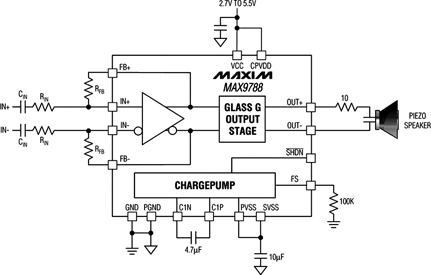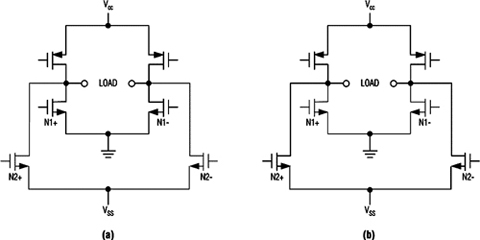
One of the main attractions for using ceramic piezoelectric speakers is their thin form factor. But to maintain the advantage of the ceramic speaker, the amplifier must also provide a compact solution. Since battery life is, moreover, one of the most important design criteria in mobile phone design, amplifier efficiency is also essential for an optimal audio solution.
Responding to these design challenges, Maxim has developed a device that uses novel technology to provide an efficient, compact solution for powering ceramic speakers.
The company's new MAX9788 is claimed to be the industry's first mono, Class G amplifier specifically designed to drive the high capacitive load of piezoelectric loudspeakers. This device integrates an inverting charge-pump power supply, which provides up to 16 Vp-p voltage drive from a single lithium ion (Li+) battery (see Figure 1). This voltage effectively doubles the available supply without using any inductors. Being available in the small, 2 x 2,5 mm UCSP package, the amplifier is ideally suited for ultra-slim electronic devices.

The design challenges of ceramic piezoelectric loudspeakers
Piezoelectric speakers are transducers that rely on the piezoelectric effect instead of a moving wire coil to generate sound. Compared to the 4 mm or greater thickness of traditional moving coil speakers, standard ceramic piezoelectric speakers are only 0,7 mm thick and often weigh less than one gramme. The small form factor associated with piezoelectric speakers is quite attractive to the portable electronics market where size and weight are significant factors.
The industry has not seen widespread use of piezoelectric loudspeakers, despite their obvious benefit in size. The lack of a good amplifier was a major obstacle preventing use of the piezoelectric speakers.
These thin ceramic loudspeakers require a significant amount of voltage drive to achieve respectable sound pressure levels. While a typical speaker used in handheld devices can only withstand 7 Vp-p, a piezoelectric speaker requires more than twice that voltage, up to 15 Vp-p to generate the same sound pressure level. This higher voltage requirement poses a problem for the speaker amplifiers typically used in handheld applications, because those amplifiers cannot generate such high voltages. Piezoelectric speakers are, furthermore, electrically similar to a ceramic capacitor; a moving coil speaker is electrically similar to an inductor. The capacitive nature of a piezoelectric speaker results in higher current draw as frequency increases, while a typical speaker requires less current as frequency increases. This fundamental difference poses great challenges for the amplifier.
Prior to the introduction of the MAX9788, piezoelectric speaker amplifiers typically used inductor-based boost converters and Class AB amplifiers to generate the necessary output voltage. While functional, the inductor for that solution requires significant board space, which leads to both a costly and a space-consuming solution. The Class AB amplifier is, moreover, inefficient and wastes battery power.
New charge-pump approach
The MAX9788 uses charge-pump technology to allow up to 16 Vp-p voltage drive from a single Li+ battery with minimal external support components. Li+ batteries typically generate 4,2 V maximum and operate down to 3,0 V as the battery discharges. Using an inverting charge pump, similar to Maxim's 'DirectDrive' technology, the MAX9788 doubles the available supply without using any inductors. Two small and inexpensive ceramic capacitors are the only external components required to generate the inverted supply.
With the creation of the second negative supply, the device's amplifier can operate from a dual supply of up to ±5,5 V, enabling the amplifier to output nearly 20 Vp-p. In typical applications the amplifier can operate from either a regulated 5 V supply or directly from the Li+ battery, in either case generating sufficient voltage to drive a piezoelectric speaker.
Maximising frequency response
Not only can the MAX9788 generate the voltage required for ceramic speakers, but it also delivers the necessary current. A ceramic speaker has the same impedance characteristics as a capacitor. Consequently, the higher the frequency, the lower the speaker's impedance becomes. To ensure that the charge pump does not collapse at high frequencies when the most current is required, the MAX9788 uses a significantly larger charge pump than typical DirectDrive amplifiers. This charge pump can deliver up to 500 mA of continuous current, which allows the amplifier to maintain flat frequency response at high frequencies and maximise sound quality.
Class G technology is uniquely suited
Since the MAX9788 uses a 10 V amplifier instead of the typical 5 V amplifiers found in handheld equipment, maintaining high efficiency is essential to maximising battery life. While Class D technology is highly efficient and often used in handheld devices, it is not compatible with ceramic speakers due to the purely capacitive load. The design challenge was clear: something else was required for the MAX9788. Class G, a relatively unknown amplifier technology, emerged as the perfect fit.
Class G amplifiers operate just like Class AB amplifiers except that Class G uses multiple supply voltages instead of one fixed voltage. As the input signal varies in amplitude, the Class G approach automatically selects the appropriate supply to minimise the voltage drop across the output transistors. Efficiency improves significantly. Typically, Class G amplifiers operate from two positive supplies and ground (see Figure 2). The high supply is used for large output levels, and the lower supply used for small output levels.

The MAX9788 also uses Class G technology uniquely, taking advantage of the inverted supply from the charge pump instead of the high and low positive supply. When the amplifier is generating a small output signal, the MAX9788 amplifier uses the battery voltage and ground as its supply. In this mode the device operates like a typical 5 V, Class AB amplifier. When the output signal exceeds the capability of the supply, the amplifier switches to using the battery voltage and the inverted charge pump output. The amplifier can then output signals sufficient for reaching a ceramic speaker's maximum sound pressure level.
| Tel: | +27 11 608 0070 |
| Email: | [email protected] |
| www: | www.cstelectronics.co.za |
| Articles: | More information and articles about CST Electronics |
| Tel: | +27 11 458 9000 |
| Email: | [email protected] |
| www: | www.electrocomp.co.za |
| Articles: | More information and articles about Electrocomp |

© Technews Publishing (Pty) Ltd | All Rights Reserved